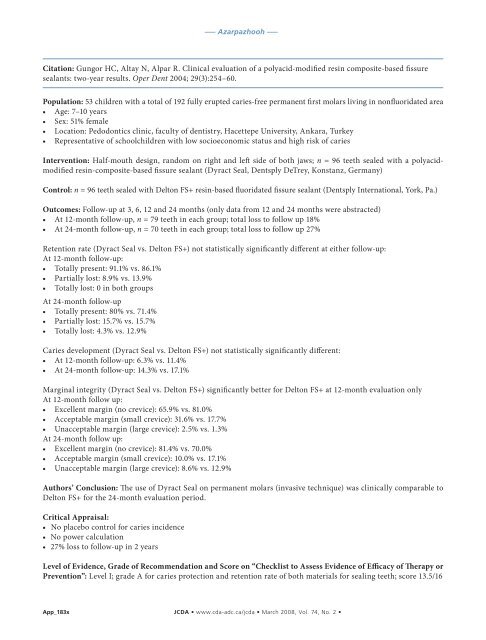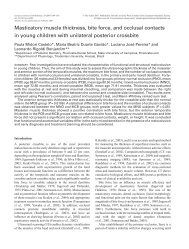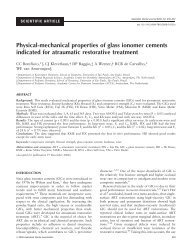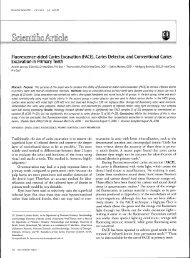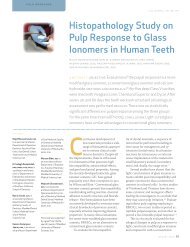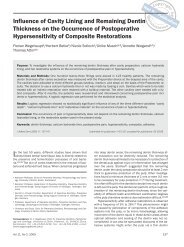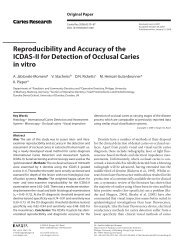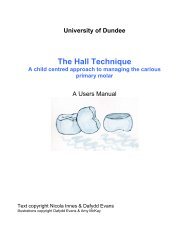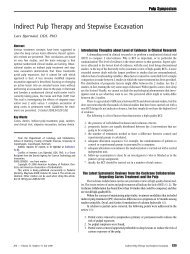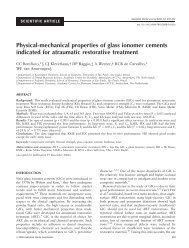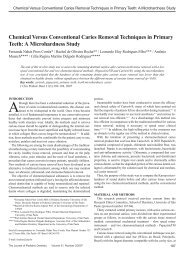Pit and Fissure Sealants in the Prevention of Dental Caries in ...
Pit and Fissure Sealants in the Prevention of Dental Caries in ...
Pit and Fissure Sealants in the Prevention of Dental Caries in ...
Create successful ePaper yourself
Turn your PDF publications into a flip-book with our unique Google optimized e-Paper software.
––– Azarpazhooh –––<br />
Citation: Gungor HC, Altay N, Alpar R. Cl<strong>in</strong>ical evaluation <strong>of</strong> a polyacid-modified res<strong>in</strong> composite-based fissure<br />
sealants: two-year results. Oper Dent 2004; 29(3):254–60.<br />
Population: 53 children with a total <strong>of</strong> 192 fully erupted caries-free permanent first molars liv<strong>in</strong>g <strong>in</strong> nonfluoridated area<br />
• Age: 7–10 years<br />
• Sex: 51% female<br />
• Location: Pedodontics cl<strong>in</strong>ic, faculty <strong>of</strong> dentistry, Hacettepe University, Ankara, Turkey<br />
• Representative <strong>of</strong> schoolchildren with low socioeconomic status <strong>and</strong> high risk <strong>of</strong> caries<br />
Intervention: Half-mouth design, r<strong>and</strong>om on right <strong>and</strong> left side <strong>of</strong> both jaws; n = 96 teeth sealed with a polyacidmodified<br />
res<strong>in</strong>-composite-based fissure sealant (Dyract Seal, Dentsply DeTrey, Konstanz, Germany)<br />
Control: n = 96 teeth sealed with Delton FS+ res<strong>in</strong>-based fluoridated fissure sealant (Dentsply International, York, Pa.)<br />
Outcomes: Follow-up at 3, 6, 12 <strong>and</strong> 24 months (only data from 12 <strong>and</strong> 24 months were abstracted)<br />
• At 12-month follow-up, n = 79 teeth <strong>in</strong> each group; total loss to follow up 18%<br />
• At 24-month follow-up, n = 70 teeth <strong>in</strong> each group; total loss to follow up 27%<br />
Retention rate (Dyract Seal vs. Delton FS+) not statistically significantly different at ei<strong>the</strong>r follow-up:<br />
At 12-month follow-up:<br />
• Totally present: 91.1% vs. 86.1%<br />
• Partially lost: 8.9% vs. 13.9%<br />
• Totally lost: 0 <strong>in</strong> both groups<br />
At 24-month follow-up<br />
• Totally present: 80% vs. 71.4%<br />
• Partially lost: 15.7% vs. 15.7%<br />
• Totally lost: 4.3% vs. 12.9%<br />
<strong>Caries</strong> development (Dyract Seal vs. Delton FS+) not statistically significantly different:<br />
• At 12-month follow-up: 6.3% vs. 11.4%<br />
• At 24-month follow-up: 14.3% vs. 17.1%<br />
Marg<strong>in</strong>al <strong>in</strong>tegrity (Dyract Seal vs. Delton FS+) significantly better for Delton FS+ at 12-month evaluation only<br />
At 12-month follow up:<br />
• Excellent marg<strong>in</strong> (no crevice): 65.9% vs. 81.0%<br />
• Acceptable marg<strong>in</strong> (small crevice): 31.6% vs. 17.7%<br />
• Unacceptable marg<strong>in</strong> (large crevice): 2.5% vs. 1.3%<br />
At 24-month follow up:<br />
• Excellent marg<strong>in</strong> (no crevice): 81.4% vs. 70.0%<br />
• Acceptable marg<strong>in</strong> (small crevice): 10.0% vs. 17.1%<br />
• Unacceptable marg<strong>in</strong> (large crevice): 8.6% vs. 12.9%<br />
Authors’ Conclusion: The use <strong>of</strong> Dyract Seal on permanent molars (<strong>in</strong>vasive technique) was cl<strong>in</strong>ically comparable to<br />
Delton FS+ for <strong>the</strong> 24-month evaluation period.<br />
Critical Appraisal:<br />
• No placebo control for caries <strong>in</strong>cidence<br />
• No power calculation<br />
• 27% loss to follow-up <strong>in</strong> 2 years<br />
Level <strong>of</strong> Evidence, Grade <strong>of</strong> Recommendation <strong>and</strong> Score on “Checklist to Assess Evidence <strong>of</strong> Efficacy <strong>of</strong> Therapy or<br />
<strong>Prevention</strong>”: Level I; grade A for caries protection <strong>and</strong> retention rate <strong>of</strong> both materials for seal<strong>in</strong>g teeth; score 13.5/16<br />
App_183x<br />
JCDA • www.cda-adc.ca/jcda • March 2008, Vol. 74, No. 2 •


